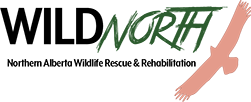Please collect the animal and bring into our Wildlife Hospital (12515 128 Street, Edmonton) as soon as possible. Please call the Wildlife Helpline ahead of time to let us know you are coming, or if you need assistance (780-914-4118).
See our contact page for hours and location.
If we are closed, please bring the animal to a 24 hour Emergency Vet Clinic
- VCA Guardian Veterinary Centre – Edmonton
- Pulse Veterinary Specialists & Emergency (24 Hours) – Sherwood Park
It is extremely important that once you have collected a wild animal you arrange to bring it to care. Do not attempt to treat wildlife on your own. WILDNorth has the ability to provide the topmost care for wildlife. Additionally, most wild animals are protected by law, and having them in captivity without a special permit could result in prosecution.
Here are a few tips for collecting mammals and birds:
- You may need leather gloves, eye protection, an old towel or sheet, and a box/carrier/crate for transport.
- Please note that the type of box you put the wild animal in is extremely important! A bird must be able to turn around in the box without damaging any of its feathers (feather integrity is very important for birds, ex: many birds of prey depend on their tail feathers to help them hover while hunting). Damaged feathers can make the difference between spending two weeks in rehabilitation versus six months!
- Make sure that any air holes are not large enough for the animal to poke its head out of, or it will do so until it is exhausted from trying to escape. Reduce the amount of visual and auditory stimuli. Dark and quiet is best.
- Use a towel or sheet (unless you are handling a porcupine) to drape over the animal before you pick it up. Do not use a towel to collect a porcupine – please get specific instructions from staff.
- Gently scoop the animal up (there are special instructions for adult hares and raptors, and any large wild animals – talk to staff before touching these animals) and place it in a cardboard box that it fits into comfortably and that is lined with a towel or paper towel.
Containers for Transport:
Containers should have a tangle free material (sheet, towel, paper towel) on the bottom to prevent the animal from sliding around during transport and the container should be large enough to allow for good ventilation. Water and food dishes should be removed when transporting.
Please cover containers with a blanket/sheet/towel, as this helps reduces visual stimuli and reduces stress levels in animals. Please keep the environment as quiet as possible, and do not peek in on the creature.
Container Suggestions
Cardboard boxes
– These work the best for most birds except ravens (they are able to pierce the box with their beaks).
– Please put holes in the box before placing the animal inside.
Plastic cat carriers
– These also work for many animals, with some exceptions. Larger birds can damage their wing and tail feathers by getting them caught in the ventilation holes (covering the holes with box board will help). These carriers work well for most small mammals except squirrels, who can chew their way through the plastic.
Plastic totes or garbage cans (with ventilation holes), or wire cages
– These work best for porcupines. Porcupines can be transported in plastic totes or metal/plastic garbage cans with ventilation holes.
– Wire cages are not recommended for most birds as they can easily damage their feathers against the wire.
